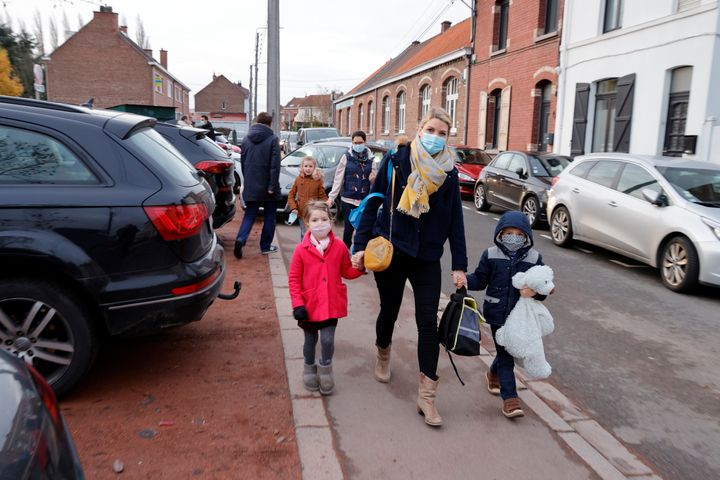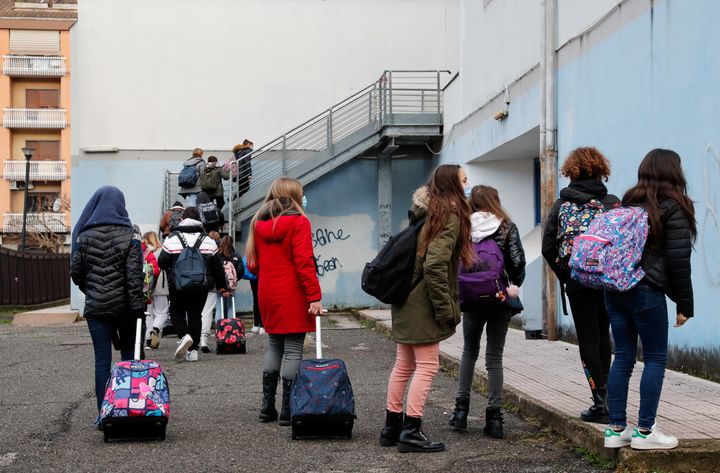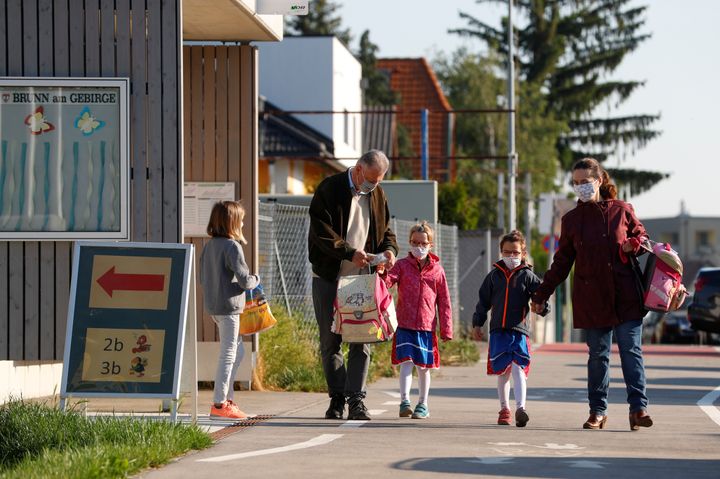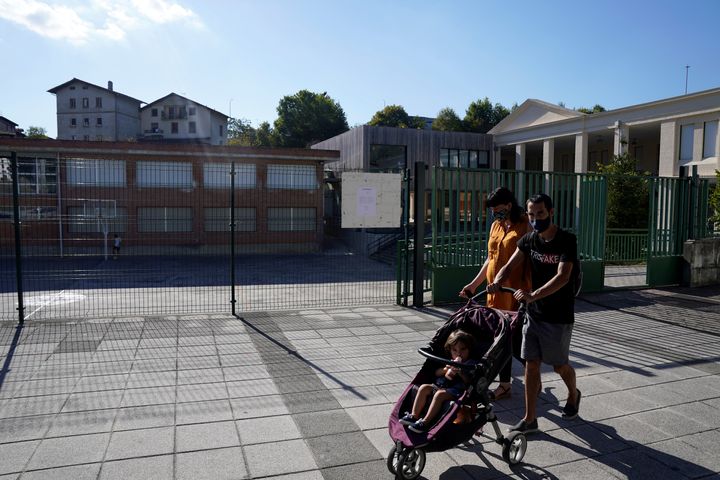While England’s schoolchildren have been cooped up at home for the entirety of 2021 so far, some of their counterparts across on the continent have been back for weeks – albeit in a manner that would have been alien one year ago.
How to reopen schools without causing further spikes in Covid cases is a problem faced by governments across Europe, and all are taking different approaches.
Boris Johnson told MPs on Monday that all pupils in all year groups can go back to the classroom from March 8, with outdoor after-school sports and activities also allowed to restart.
Face masks are recommended for students in secondary schools, and those same students will be tested for Covid-19 twice a week.
The mass testing of secondary school students had been planned and was ready to implement for what was the aborted reopening of schools in the New Year.
Instead it was only used for children of vulnerable parents and key workers who were still allowed to attend school. Lateral flow tests, which can give results in 30 minutes, have been administered twice a week, three to five days apart.
Here’s what England can learn from its European neighbours.
France
Schools and shops are open but cafes, restaurants and bars are shut, along with theatres, cinemas, museums and galleries. A nationwide curfew is in place between the hours of 6pm and 6am.
No date has been set for re-opening.
Beginning this week, France will carry out between 50,000 to 80,000 tests on students, rising to 200,000 next week, with an emphasis on testing pupils returning from the February school holidays.
Using saliva tests, students will be required to spit into a tube from a kit, at school or at home. The sample is then analysed during the day with a final result within 24 hours.

The saliva tests have been a priority for France’s national education minister, Jean-Michel Blanquer, who fears infection rates in schools could increase after the French “winter break” – a week-long February holiday, similar to half-term, that is staggered over three different weeks depending where in France you live.
The French government decided to reopen schools after Christmas, despite infection rates remaining high across the country.
This saliva test, which avoids a nasal or throat swab, has a sensitivity of 85%. Students are told not to take their sample within 30 minutes of eating or brushing their teeth. For children under six, saliva can be collected using a small pipette.
“With the saliva tests, we think that almost everyone will agree to be tested,” Blanquer said, HuffPost France reports.
Italy
Italy has 95,500 confirmed deaths from Covid – Europe’s second-highest pandemic toll after Britain. Experts say the virus also killed many others who were never tested.
While the first wave of infections largely engulfed Lombardy and other northern regions, a second surge starting in the autumn of 2020 has raced through the country.
Italy is divided into red, orange, yellow and white zones and restrictions vary accordingly.
Orange zone means bars and restaurants are closed and people cannot leave their towns of residence except for work or emergencies.
Schools are closed in these regions but open, at least partly, in yellow zones.
But even a phased reopening of schools that began on February 1, with many only welcoming half their students, has been hit by problems.

One of the biggest obstacles has been the logistics of safely getting children to and from school without the virus spreading to the wider community.
Luca Cascone, president of Campania’s Regional Transport Commission, told HuffPost Italia: “From an organisational point of view, we are ready but we remain convinced that schools, especially high schools, represent a critical issue.”
Elsewhere, headteachers reported that pupils were being sent to school despite family members testing positive.
New prime minister Mario Draghi is also considering reshaping the school calendar to help students catch up on lost learning, potentially extending classes into the traditional summer recess by up to a month.
Austria
A lockdown was eased this month despite high infections. Shops and hairdressers are now open and schools have in-person lessons, with daily testing.
A night time curfew is in place and there are restrictions on leaving Tyrol province because of an outbreak of the South African variant. No easing measures are planned until Easter at the earliest.
Austria has ordered five million rapid tests for schools, and pupils and teachers are required to take at least one test a week.
Despite infection rates remaining roughly twice the “ideal” level, Austria reopened classrooms on February 8. However, only pupils who have been tested are allowed to attend lessons, with others able to join online.
“Testing is the right answer to bridge the difficult months until the vaccine coverage is complete,” Austria’s education minister Werner Fassmann said.

Parents of younger children will be asked to test their children at home, while older pupils will be able to test themselves at school and their classes are split into separate groups.
“There will be parents who refuse,” Fassmann said. “But overall this is an opportunity not only to open up the schools, but also to keep them open.”
The tests, which take place each Monday on students aged six and above, require a swab only to be inserted into the front area of the nasal cavity and do not require a throat swab, making them easier to perform.
An Austrian government video showing students how to conduct the self-test describes the process as “just like picking your nose”.
The results are visible within 15 minutes, making them suitable for quickly identifying people who are highly infectious. People who test positive have to notify the authorities for further testing.
The government said the sensitivity of nasal tests is comparable to the conventional throat swab tests, citing separate studies by the Charite hospital in Berlin and the Austrian Agency for Health and Food Safety.
Teachers are due to get vaccines from late February, although there is no mandatory requirement for them to be vaccinated.
Students are required to wear mouth and nose protection in school.
Austria, a country of 8.9m people, is in its third lockdown, with only essential shops open. The country has reported 379,071 coronavirus cases and 6,687 Covid-19 linked deaths since the pandemic began last year.
Spain
Restrictions vary across Spain, with Madrid taking a relaxed approach and allowing customers to eat and drink inside bars and restaurants until 11pm.
Most other regions are much stricter, but some have started to ease local travel restrictions and reopen non-essential businesses, though curfews remain in place between 10pm and midnight nationwide.
Schools in Spain largely reopened as planned in early January after the Christmas holidays.

Despite national figures showing a record 25% rise in infections in January over a 14-day period, figures in early February showed less than 2% of classes were suspended.
“[Schools are] one of the areas that have worked best, where there has been the most control. There were no outbreaks,” senior health official María José Sierra said in early January.
In fact, figures from the Catalan government found that an infected person in schools passed the virus on to an average of just 0.4 people.
While there are some regional variations, students aged six and over are required to wear face coverings, class sizes are often reduced and pupils regularly alternate between attending class and home learning.
